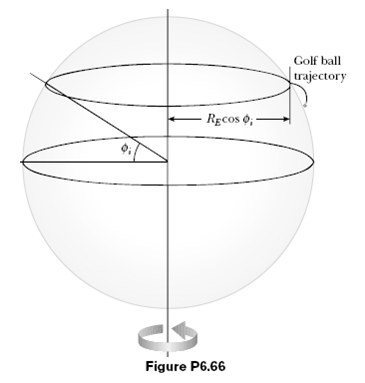An example of the Coriolis effect supposes air resistance is negligible for a golf ball. A golfer
Question:
An example of the Coriolis effect supposes air resistance is negligible for a golf ball. A golfer tees off from a location precisely at θi = 35.0° north latitude. He hits the ball due south, with range 285 m. The ball’s initial velocity is at 48.0° above the horizontal.
(a) For how long is the ball in flight? The cup is due south of the golfer’s location, and he would have a hole-in-one if the Earth were not rotating. The Earth’s rotation makes the tee move in a circle of radius RE cos θi = (6.37 x 106 m) cos 35.0°, as shown in Figure P6.66. The tee completes one revolution each day.
(b) Find the eastward speed of the tee, relative to the stars. The hole is also moving east, but it is 285 m farther south, and thus at a slightly lower latitude 1f. Because the hole moves in a slightly larger circle, its speed must be greater than that of the tee.
(c) By how much does the holes speed exceed that of the tee? During the time the ball is in flight, it moves upward and downward as well as southward with the projectile motion you studied in Chapter 4, but it also moves eastward with the speed you found in part
(b) The hole moves to the east at a faster speed, however, pulling ahead of the ball with the relative speed you found in part (c).
(d) How far to the west of the hole does the ball land?

Step by Step Answer:

Canadian Business & the Law
ISBN: 978-0176501624
4th edition
Authors: Dorothy DuPlessis, Shannnon o'Byrne, Steven Enman, Sally Gunz





